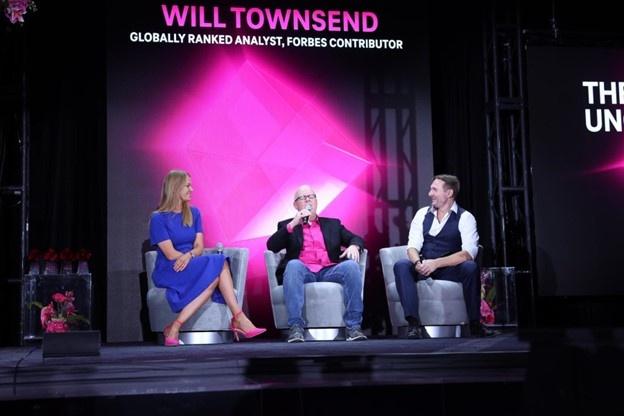Last week I crossed the country from Manhattan to Las Vegas to attend Mobile World Congress. Judging from the vendor booth area, the event seemed lightly attended, and others I met agreed with my take on that. GSMA has done a lot to boost attendance for MWC Las Vegas, which was formerly a CTIA event that struggled with inconsistent participation given its singular focus on legislative and regulatory policy and certification efforts. However, it seemed apparent that this year many people stayed home, likely waiting for the signature MWC event in Barcelona early next year.
In this post, I’d like to share my insights related to some of the more compelling announcements from MWC Las Vegas.
T-Mobile Gets SASE
T-Mobile has firmly anchored its business services awareness campaign to MWC Las Vegas. In its second year at the event, the Unconventional Awards highlighted T-Mobile for Business customers that leverage connectivity in unique ways. I served as one of the judges again, and it was a night filled with celebration and accolades. T-Mobile has come a long way in developing a strong portfolio of enterprise connectivity solutions, and it made an important announcement the same week tied to its new secure access service edge offering in partnership with Versa Networks.
At a high level, T-Mobile is bringing differentiation to a crowded SASE market that converges software-defined wide-area networking and security with two new features. First, “T-SIMsecure” represents the industry’s first SIM-based clientless authentication SASE scheme. By leveraging the SIM found in every mobile device, T-Mobile can automatically validate users simply and quickly, significantly reducing the complexity associated with identity access management. What is also compelling is the extensibility of this solution to IoT devices that traditionally have been unable to support SASE software.
The second feature is T-Mobile’s Security Slice, which leverages its 5G Standalone network deployment to offer a virtual network slice dedicated to SASE traffic. Network slicing is one of the most impactful capabilities facilitated by the 5G standard. T-Mobile now allows its business customers to isolate specific users and fine-tune networking aspects such as latency and throughput for specific application requirements. I like the approach, and the T-Mobile SASE offering builds upon a longstanding relationship that dates back to Sprint’s partnership with Versa before its merger with T-Mobile.
NTT and its private 5G journey momentum
Moving on to NTT, I continue to be impressed with this company as it builds momentum with its private 5G offerings. At MWC Las Vegas, NTT announced a partnership with Qualcomm to develop new 5G-enabled devices and utilize AI to enhance data processing at the network edge. It also enables scalability with this effort; by offering a device-as-a-service model that allows organizations to treat hardware as an operational expense, the company allows customers to take advantage of a monthly subscription model and forego considerable upfront investment costs.
NTT Docomo, the company’s public mobile network operations division, also announced new services tied to its OREX platform. OREX is the carrier’s Open RAN service that includes a partnership with 13 companies to ensure turnkey integration. Integration is crucial given the disaggregated nature of Open RAN’s use of industry-standard servers and software to deliver radio access network functionality. To accomplish this objective, OREX offers three packages. The first includes virtualized radio base stations and wireless equipment. The second encompasses software that enables autonomous equipment operations and system integration, and the third delivers maintenance and operational support. On the surface, this looks like an important offering that has the potential to significantly reduce the complexity and risk of deploying Open RAN.
At MWC Las Vegas, I also met with NTT leadership and one of its strategic partners, Schneider Electric. The companies have been working together over the past few years toward enabling industrial customers to realize the promise of digital transformation. Schneider offers a full-stack, micro-datacenter platform hardened for factory deployment, and NTT provides the requisite private 5G connectivity. By combining both, NTT and Schneider have developed a compelling smart factory solution, one that can take advantage of use cases that span automated guided vehicle deployments, machine vision applications to ensure higher performance and availability and augmented reality applications that have the potential to improve worker skills for enhanced support and maintenance. From my perspective, manufacturing automation is one of 5G’s killer use cases, and the NTT-Schneider tie-up is making it a reality.
Samsung Extends Its VRAN Leadership
Samsung Networks continues building its leadership position in the virtualized RAN space. Two announcements at MWC Las Vegas are worth mentioning. The first centered on Samsung’s collaboration with AMD, which marries Samsung’s vRAN software with the new EPYC 8004 processor line. The partnership aims to reduce power consumption and improve performance for telco edge and RAN deployments.
The second announcement covers the formation of a new alliance with mobile network operator KDDI. Dubbed the 5G Global Network Slice Alliance, the two companies plan to collaborate to create new 5G network slicing services. I mentioned the power of network slicing above in the context of T-Mobile’s new SASE offering, and I applaud Samsung and KDDI’s efforts to accelerate adoption even further.
Wrapping Up
MWC Las Vegas may have been light in attendance this year, but it still served as a conduit for a handful of standout announcements. As 2023 ends, I see great potential for 5G as public mobile network operators transition to Standalone deployments and as private 5G adoption accelerates. Next year should be a wild ride as 5G hits its stride with truly compelling consumer and enterprise services.
Moor Insights & Strategy provides or has provided paid services to technology companies like all research and tech industry analyst firms. These services include research, analysis, advising, consulting, benchmarking, acquisition matchmaking, and video and speaking sponsorships. The company has had or currently has paid business relationships with 8×8, Accenture, A10 Networks, Advanced Micro Devices, Amazon, Amazon Web Services, Ambient Scientific, Ampere Computing, Anuta Networks, Applied Brain Research, Applied Micro, Apstra, Arm, Aruba Networks (now HPE), Atom Computing, AT&T, Aura, Automation Anywhere, AWS, A-10 Strategies, Bitfusion, Blaize, Box, Broadcom, C3.AI, Calix, Cadence Systems, Campfire, Cisco Systems, Clear Software, Cloudera, Clumio, Cohesity, Cognitive Systems, CompuCom, Cradlepoint, CyberArk, Dell, Dell EMC, Dell Technologies, Diablo Technologies, Dialogue Group, Digital Optics, Dreamium Labs, D-Wave, Echelon, Ericsson, Extreme Networks, Five9, Flex, Foundries.io, Foxconn, Frame (now VMware), Fujitsu, Gen Z Consortium, Glue Networks, GlobalFoundries, Revolve (now Google), Google Cloud, Graphcore, Groq, Hiregenics, Hotwire Global, HP Inc., Hewlett Packard Enterprise, Honeywell, Huawei Technologies, HYCU, IBM, Infinidat, Infoblox, Infosys, Inseego, IonQ, IonVR, Inseego, Infosys, Infiot, Intel, Interdigital, Jabil Circuit, Juniper Networks, Keysight, Konica Minolta, Lattice Semiconductor, Lenovo, Linux Foundation, Lightbits Labs, LogicMonitor, LoRa Alliance, Luminar, MapBox, Marvell Technology, Mavenir, Marseille Inc, Mayfair Equity, Meraki (Cisco), Merck KGaA, Mesophere, Micron Technology, Microsoft, MiTEL, Mojo Networks, MongoDB, Multefire Alliance, National Instruments, Neat, NetApp, Nightwatch, NOKIA, Nortek, Novumind, NVIDIA, Nutanix, Nuvia (now Qualcomm), NXP, onsemi, ONUG, OpenStack Foundation, Oracle, Palo Alto Networks, Panasas, Peraso, Pexip, Pixelworks, Plume Design, PlusAI, Poly (formerly Plantronics), Portworx, Pure Storage, Qualcomm, Quantinuum, Rackspace, Rambus, Rayvolt E-Bikes, Red Hat, Renesas, Residio, Samsung Electronics, Samsung Semi, SAP, SAS, Scale Computing, Schneider Electric, SiFive, Silver Peak (now Aruba-HPE), SkyWorks, SONY Optical Storage, Splunk, Springpath (now Cisco), Spirent, Splunk, Sprint (now T-Mobile), Stratus Technologies, Symantec, Synaptics, Syniverse, Synopsys, Tanium, Telesign,TE Connectivity, TensTorrent, Tobii Technology, Teradata,T-Mobile, Treasure Data, Twitter, Unity Technologies, UiPath, Verizon Communications, VAST Data, Ventana Micro Systems, Vidyo, VMware, Wave Computing, Wellsmith, Xilinx, Zayo, Zebra, Zededa, Zendesk, Zoho, Zoom, and Zscaler. Moor Insights & Strategy founder, CEO, and Chief Analyst Patrick Moorhead is an investor in dMY Technology Group Inc. VI, Fivestone Partners, Frore Systems, Groq, MemryX, Movandi, and Ventana Micro., MemryX, Movandi, and Ventana Micro.
Read the full article here








